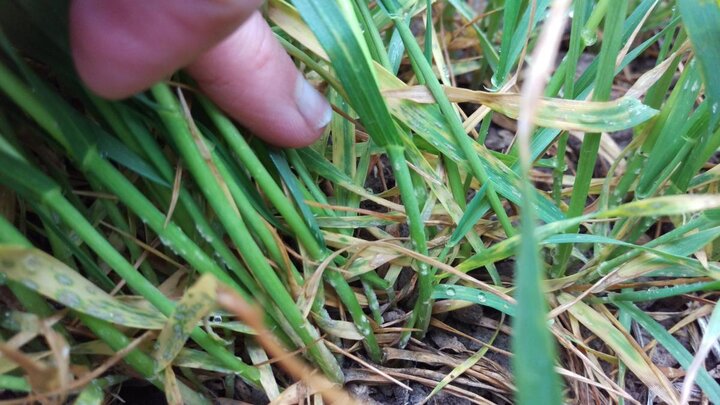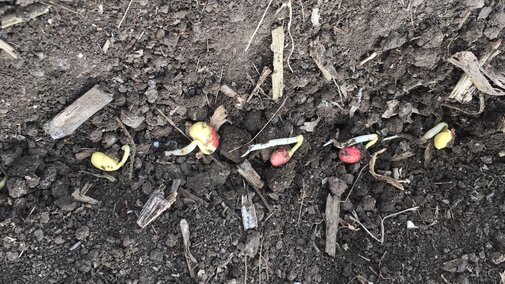
Jenny Rees, Extension Educator, York: Planters have been rolling the past week until spotty rains kept some out of the fields. Planting progress ranges from some farmers being completely done with corn and soybean to those who still have either corn or soybean left to plant. More farmers in the southern area I serve planted soybean before corn or corn/soy at the same time. Several on-farm research studies have also gone in the past week as has the York County Corn Grower plot. Areas that haven’t received rains are getting dry in the seedbed from high winds and some farmers began running pivots to settle dust, activate herbicide, and add moisture to the seed bed. Wheat is now jointed in this area and ranges in height depending on moisture. This week I was finding bird cherry oat aphids and lady bugs in wheat. The aphids can vector barley yellow dwarf virus. Many had talked about leaves appearing yellow. In the lower canopies of most fields I was finding powdery mildew. Also found tan spot in wheat. More info with pictures can be found at http://jenreesources.com.

Randy Pryor, Extension Educator, Wilber: We went from less than 1% of corn planted the week before to at least 59% yesterday. Individual farmers reporting being 50-90% done. I've received several questions about “Do I plant into partly dead cereal rye that is only 3-4 inches tall?” The recommendation was to plant, making sure corn is not planted too shallow. Extension Engineer Paul Jasa has reported problems with shallow-planted corn in partially terminated tall cereal rye. The Southeast Corn Growers’ dryland plot was planted Monday with two entries each from 10 companies. Even though it was a no-till field, the planter created a lot of dust each pass in winds 30 to 50 mph. (May 1, 2018)
Jessica Groskopf, Extension Educator for Agricultural Economics, Scottsbluff: Corn prices are up a little and there are some marketing opportunities. It’s time to empty some bins and do some pre-pricing. Prices tend to bump up at this time of year and we’re seeing a little change in the basis. This is also a good time to download and use the Grain Marketing Ap, now available for Apple and Android. (May 1, 2018)
Gary Stone, Extension Educator, Scottsbluff: A lot of corn and sugar beets are being planted. Wheat looks good in this area. (May 1, 2018)
Robert Tigner, Extension Agricultural Systems Economist Educator, North Platte: Moisture here has been spotty, but planters are running now. We’re a little behind, but with these 32-row corn planters they’ll catch up quickly. (May 1, 2018)
Todd Whitney, Extension Educator, Holdrege: Planting started hard on Friday, continuing into this week, even with winds up to 35 mph Monday. I expect most of the planting will be completed in the next two to three days. (May 1, 2018)
Ron Seymour, Extension Educator, Hastings: Wheat is around 6 inches and hasn’t jointed yet; alfalfa is about the same height. Cover crops are 1-8 inches. In the last couple of weeks a few fields were planted here and there, but serious planting started Friday. It’s been dry and windy here and we need moisture, but there’s enough to get the crop started for now. (May 1, 2018)
Steve Melvin, Extension Educator, Central City: We have a lot of ridge-till and furrow irrigation in the Platte Valley, thus we’re seeing tillage to build/rebuild the ridges. A lot of cover crops have been sprayed and are dying. We visited Soybean Management Field Day sites near Albion and just south of Kenesaw where we installed soil moisture sensors. (May 1, 2018)
Aaron Nygren, Extension Educator, Schuyler: In the last week we installed soil moisture sensors at the Cedar Bluffs and Hartington Soybean Management Field Day sites. There’s only 1-2 inches of cover crop growth at the site planted Nov. 10. Cover crop termination at these sites is being delayed to allow for more biomass growth, with soybeans being planted in mid- May. I'm seeing more soybeans than corn being planted at this time. (May 1, 2018)
Megan Taylor, Extension Educator, Columbus: Planters were busy Saturday and Sunday and a lot of soybeans are going in. In the heavy residue fields I’m seeing a lot of small marestail that didn't die after a herbicide treatment. (May 1, 2018)
Nathan Mueller, Extension Educator, Fremont: About 25% of the corn and 5-10% of the soybeans were planted in the last two days. Planting of oats and alfalfa is finished. We’re seeing some wind erosion, mainly in alfalfa that had been tilled. In this area we’re seeing the same or less tillage than usual. In about 20 fields growers planted green, directly into rye cover crop. Some wheat is tillering and some is likely to joint this week. Growers are behind on spraying due to high winds and now need to plant. (May 1, 2018)
John Wilson, Extensin Educator, Tekamah: Planting is going fast and furious here as growers are trying to beat the rain predicted for this week. We’re about a third done with corn planting and have a good start on beans. Thousands of CRP acres were burned in this area this year. (May 1, 2018)
Tom Hunt, Extension Entomologist, Haskell Ag Lab, Concord: We got 0.5-1 inch of rain here last night. There’s been some disking and corn planting is just starting. It was wet up to a couple days ago. (May 1, 2018)
Chris Proctor, Extension Educator Weed Science, Lincoln: We’ve been studying fall versus spring herbicide applications for control of marestail for two years and it’s notable how much better control we get with fall application. Winter annuals seem to be more susceptible in the fall. Cover crop growth has been slow, but is taking off. Planting date in the fall makes a huge difference in the amount of spring biomass. (May 1, 2018)
Gary Lesoing, Extension Educator, Auburn: About two-thirds of the corn has been planted and some beans are in. Last week we got .25-.30 inch of rain and we definitely could use more rain. We have several on-farm research studies we're leading or collaborating on in the area. With winds over 40 mph here and a lot of dust blowing, you could really see the difference between fields with and without cover crops. Cover crop growth was slow this spring and a lot of cover crop fields have already been sprayed out. We’ve found some variegated cutworms, but not a lot of black cutworm moths. (May 1, 2018)
Tyler Williams, Extension Educator, Lincoln: East central Nebraska soil moisture is now quite dry at least in the top few inches; rainfall is 3 inches below normal. It’s quite uncommon to get little or no rain in April. (May 1, 2018)

